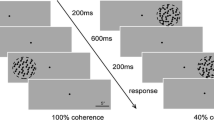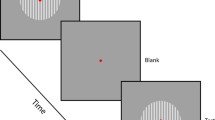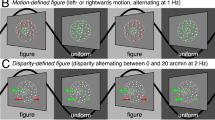Abstract
Successive stages of cortical processing encode increasingly more complex types of information. In the visual motion system this increasing complexity, complemented by an increase in spatial summation, has proven effective in characterizing the mechanisms mediating visual perception. Here we report psychophysical results from a motion-impaired stroke patient, WB, whose pattern of deficits over time reveals a systematic shift in spatial scale for processing speed. We show that following loss in sensitivity to low-level motion direction WB’s representation of speed shifts to larger spatial scales, consistent with recruitment of intact high-level mechanisms. With the recovery of low-level motion processing WB’s representation of speed shifts back to small spatial scales. These results support the recruitment of high-level visual mechanisms in cases where lower-level function is impaired and suggest that, as an experimental paradigm, spatial summation may provide an important avenue for investigating functional recovery in patients following damage to visually responsive cortex.






Similar content being viewed by others
References
Ahissar M, Hochstein S (2004) The reverse hierarchy theory of visual perceptual learning. Trends Cogn Sci 8:457–464
Beardsley SA, Vaina LM (2001) A laterally interconnected neural architecture in MST accounts for psychophysical discrimination of complex motion patterns. J Comput Neurosci 10:255–280
Beardsley SA, Vaina LM (2004) A functional architecture for motion pattern processing in MSTd. In: Thrun S, Saul L, Schölkopf B (eds) Advances in neural information processing systems 16. MIT Press, Cambridge, MA, pp 1451–1458
Beardsley SA, Vaina LM (2005a) How can a patient blind to radial motion discriminate shifts in the center-of-motion? J Comput Neurosci 18:55–66
Beardsley SA, Vaina LM (2005b) Psychophysical evidence for a radial motion bias in complex motion discrimination. Vision Res 45:1569–1586
Bex PJ, Makous W (1997) Radial motion looks faster. Vision Res 37:3399–3405
Bex PJ, Metha AB, Makous W (1998) Psychophysical evidence for a functional hierarchy of motion processing mechanisms. J Opt Soc Am A Opt Image Sci Vis 15:769–776
Burr DC, Morrone MC, Vaina LM (1998) Large receptive fields for optic flow detection in humans. Vision Res 38:1731–1743
Carpenter GA, Grossberg S (1987) A massively parallel architecture for a self-organizing neural pattern recognition machine. Comp Vis Graph Image Proc 37:54–115
Clifford CWG, Beardsley SA, Vaina LM (1999) The perception and discrimination of speed in complex motion. Vision Res 39:2213–2227
Deco G, Lee TS (2004) The role of early visual cortex in visual integration: a neural model of recurrent interaction. Eur J Neurosci 20:1089–1100
Deco G, Rolls ET (2004) A neurodynamical cortical model of visual attention and invariant object recognition. Vision Res 44:621–642
Deco G, Zihl J (2001) A neurodynamical model of visual attention: feedback enhancement of spatial resolution in a hierarchical system. J Comput Neurosci 10:231–253
Geesaman BJ, Qian N (1996) A novel speed illusion involving expansion and rotation patterns. Vision Res 36:3281–3292
Geesaman BJ, Qian N (1998) The effect of complex motion pattern on speed perception. Vision Res 38:1223–1231
Hahnloser RH, Douglas RJ, Hepp K (2002) Attentional recruitment of inter-areal recurrent networks for selective gain control. Neural Comput 14:1669–1689
Hatsopoulos NG, Warren WH (1991) Visual navigation with a neural network. Neural Netw 4:303–317
Hochstein S, Ahissar M (2002) View from the top: hierarchies and reverse hierarchies in the visual system. Neuron 36:791–804
Lee TS, Mumford D (2003) Hierarchical Bayesian inference in the visual cortex. J Opt Soc Am A Opt Image Sci Vis 20:1434–1448
Meese TS, Anderson SJ (2002) Spiral mechanisms are required to account for summation of complex motion components. Vision Res 42:1073–1080
Meese TS, Harris MG (2001) Independent detectors for expansion and rotation, and for orthogonal components of deformation. Perception 30:1189–1202
Morrone MC, Burr DC, Vaina LM (1995) Two stages of visual processing for radial and circular motion. Nature 376:507–509
Mumford D (1992) On the computational architecture of the neocortex. II. The role of cortico-cortical loops. Biol Cybern 66:241–251
Pelli DG (1997) The VideoToolbox software for visual psychophysics: transforming numbers into movies. Spat Vis 10:437–442
Perrone JA, Stone LS (1998) Emulating the visual receptive-field properties of MST neurons with a template model of heading estimation. J Neurosci 18:5958–5975
Raizada RD, Grossberg S (2003) Towards a theory of the laminar architecture of cerebral cortex: computational clues from the visual system. Cereb Cortex 13:100–113
Sekuler AB (1992) Simple-pooling of unidirectional motion predicts speed discrimination for looming stimuli. Vision Res 32:2277–2288
Tyler CW, Chen CC (2000) Signal detection theory in the 2AFC paradigm: attention, channel uncertainty and probability summation. Vision Res 40:3121–3144
Usher M, Niebur E (1996) Modelling the temporal dynamics of IT neurons in visual search: a mechanism for top-down selective attention. J Cogn Neurosci 8:311–327
Vaina LM, Gryzwacz NM, Saiviroonporn P, LeMay M, Bienfang DC, Cowey A (2003) Can spatial and temporal motion integration compensate for deficits in local motion mechanisms? Neuropsychologia 41:1817–1836
Watamaniuk SN, Duchon A (1992) The human visual system averages speed information. Vision Res 32:931–941
Watamaniuk SNJ, Sekuler R (1992) Temporal and spatial integration in dynamic random-dot stimuli. Vision Res 32:2341–2347
Zemel RS, Sejnowski TJ (1998) A model for encoding multiple object motions and self-motion in area MST of primate visual cortex. J Neurosci 18:531–547
Acknowledgments
This work was supported by National Institutes of Health grant 5R01EY007861-14 to LMV. We thank Paola Favaretto for helping with data collection. We also thank the subjects, especially WB, for their participation in this study.
Author information
Authors and Affiliations
Corresponding author
Rights and permissions
About this article
Cite this article
Beardsley, S.A., Vaina, L.M. Global motion mechanisms compensate local motion deficits in a patient with a bilateral occipital lobe lesion. Exp Brain Res 173, 724–732 (2006). https://doi.org/10.1007/s00221-006-0447-1
Received:
Accepted:
Published:
Issue Date:
DOI: https://doi.org/10.1007/s00221-006-0447-1




